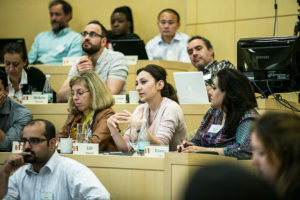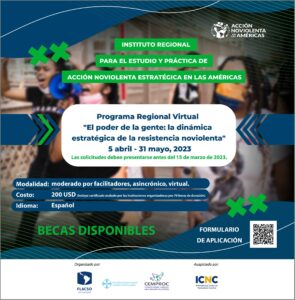Minds of the Movement
An ICNC blog on the people and power of civil resistance
by Hardy MerrimanJune 07, 2023
This is the second in a two-part series (first blog post is here) on supporting educational infrastructure for civil resistance movements.
The field of civil resistance has developed significantly in recent decades. Building from humble beginnings, it now receives national and international attention, and has numerous institutions, trainers, programs, and networks dedicated to it.
Obscured by this growth, however, is a troubling trend—the field still has an unacceptable rate of attrition. This has become a regular conversation topic with my colleague Ivan Marovic, as we discuss how we were each fortunate to be able to make career paths dedicated to civil resistance and movement organizing. We agree that a core weakness is that the field lacks a clear talent pipeline, and this must be remedied to ensure sustainability and long-term growth. Structures and processes must be established to enable more new people to enter the field; gain knowledge, experience, skills, mentorship, and connections in a relatively systematic way; and then ultimately be able to practice as part of their livelihood.
There is a vast and brilliant pool of individuals to draw from—those who practice or seek to study civil resistance suffer no lack of talent, motivation, or creativity. But we have insufficient resources to provide them consistently with on-ramps and increasing opportunities (including education, practice, and funding). Many people who want to learn more can’t find mentorship. And for those who do, our pipeline doesn’t support most of them beyond a few initial steps. Opportunities for advancement are often ad hoc and don’t pay adequately, if at all. In light of such uncertainty and inconsistency, many talented people ultimately leave, and enter party politics, traditional advocacy-oriented NGOs, or whatever job they can find to pay the bills.
This state of affairs is understandable, given that civil resistance has received little institutional or financial support relative to other disciplines. It’s not a topic that most powerholders have historically wanted to promote. Despite the scarcity of resources, it’s been remarkable what infrastructure has been able to stand up so far, although it’s not nearly enough.
We have a rare opportunity to address this challenge now, and we should use it. As a surge of interest in civil resistance movements is growing among funders, some portion of resources should be channeled to help sustain this field as a whole. Here’s a model of mutually reinforcing structures that could be developed to achieve this.
Five pillars of educational infrastructure:
Nearly every vocation—from medicine, to law, to engineering, to military service—has five areas of activity that help to sustain it. They are:
1. Research (academic and applied)
2. Educational and skill-building opportunities
3. Materials production (including translations)
4. Professional associations and networking
5. Funding for practice

Participants at the 2016 ICNC Summer Institute for the Advanced Study of Nonviolent Conflict, one of ICNC's former flagship programs for scholars, activists, and civil society professionals. Source: ICNC.
Together, these five pillars enable continuity and growth. Research takes place and gets incorporated into most vocational fields regularly. Students have opportunities for systematic instruction and mentorship. Materials are produced to support learning. Associations are set up to serve practitioners, foster networks, set standards in the field, and distribute new insights. Lastly, practitioners can get paid to do this work.
These five pillars are part of ICNC’s program strategy, and for years we have made investments in, and experimented with, each of them at various times. Specifically we find that when we intentionally cluster and interlink these efforts, the net impact is far greater than the sum of its parts, because the pillars reinforce each other.
For example, people from over 100 countries around the world have engaged in ICNC’s in-depth educational seminars, workshops, and courses; and this has fostered cross-pollination of ideas and the formation of networks. These educational opportunities have also enabled identification of talented organizers and activists who want more opportunities to practice and increase their skills, and we’ve responded by offering funding and additional educational programs to support them becoming trainers, coaches, researchers, translators and developers of new learning materials. We’ve also supported research on topics relevant to practitioners, produced educational materials that incorporate its findings, and used workshops and seminars as opportunities to expose activists to this work, to connect them with scholars, and to have them inform future research agendas.

ICNC organizes Regional Institutes on the Study and Practice of Strategic Nonviolent Action in partnership with local organizations in different parts of the world. Above, a flyer for the Spanish-language Virtual Regional institute on Nonviolent Action in the Americas in 2021.
As we’ve reflected on what we’ve learned from examples like these, several things have become clear.
First, this model works—integrating activities from the five pillars creates a rich network of synergies where people can gravitate to different roles for which they feel naturally suited.
Second, it’s easy to run out of next steps. Even when we developed three-step and four-step processes to support individuals and continue to offer opportunities over 12-24 months, we could not sustain the process after a certain point, and thus the risk of attrition returned when the steps ran out. In some cases, even having a gap of several months between steps could lead to attrition, since people need income and don’t necessarily have the reserves to wait.
Third, even as we seek to emulate some aspects of models used in other vocational paths, we don’t want to blindly copy them. For example, we don’t want to professionalize the field in a way that creates barriers to entry. Instead, we want to enable and support durable structures capable of wide reach (enabling high accessibility of knowledge, with low barriers to entry) as well as depth (enabling a pathway of deepening knowledge, skills, and support to highly motivated practitioners).
Lastly, it’s clear that long-term sustainability requires local rooted-ness of the five pillars in diverse geographic regions. Based on this view, we began a process of supporting local partners in Nepal, Ukraine, and Ecuador to establish regional institutes that could serve this purpose, and this has yielded some promising results.
Our field is at an inflection point. We’ve grown. We’re in demand. We have opportunity. But this should not distract us from the fact that we have significant gaps to fill. As funding rises for this work, we do not know how long the influx of resources will last, and we should consistently ask ourselves the question of how we can use this time to foster and support structures that create sustainability. We need to ensure that the next generation of activists, researchers, and movement allies have clear paths of learning, mentorship, skill development, network building, and funding for practice. If we do this, we can create a cycle that endures and grows for decades to come.

Hardy Merriman
Hardy Merriman is President of the International Center on Nonviolent Conflict (ICNC), and led ICNC as President & CEO from 2015 until 2021. He has worked in the field of civil resistance for over 20 years, presenting at workshops for activists and organizers; speaking widely to scholars, journalists, and members of international organizations; and developing educational resources.
Read More